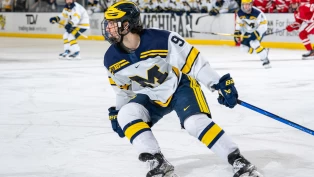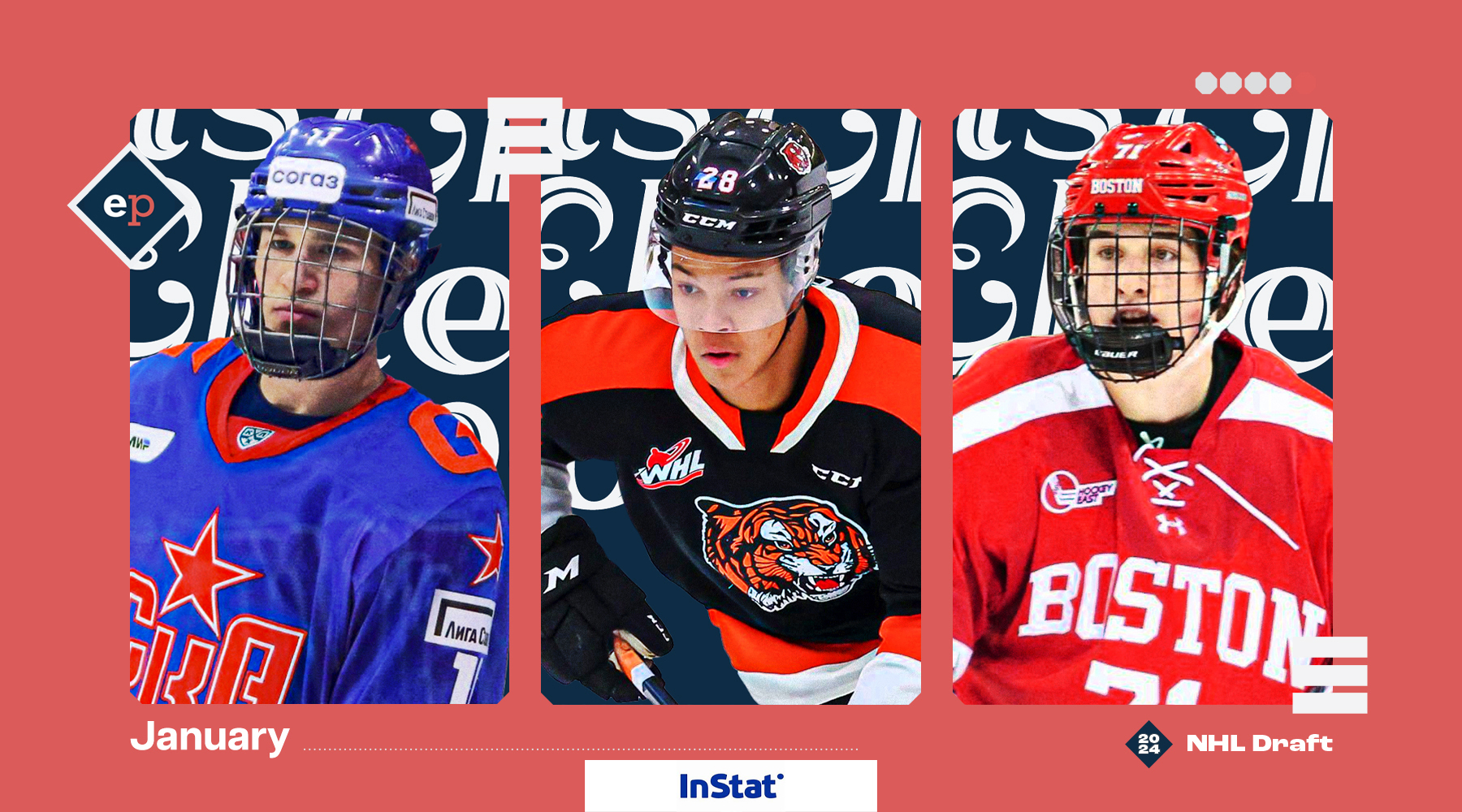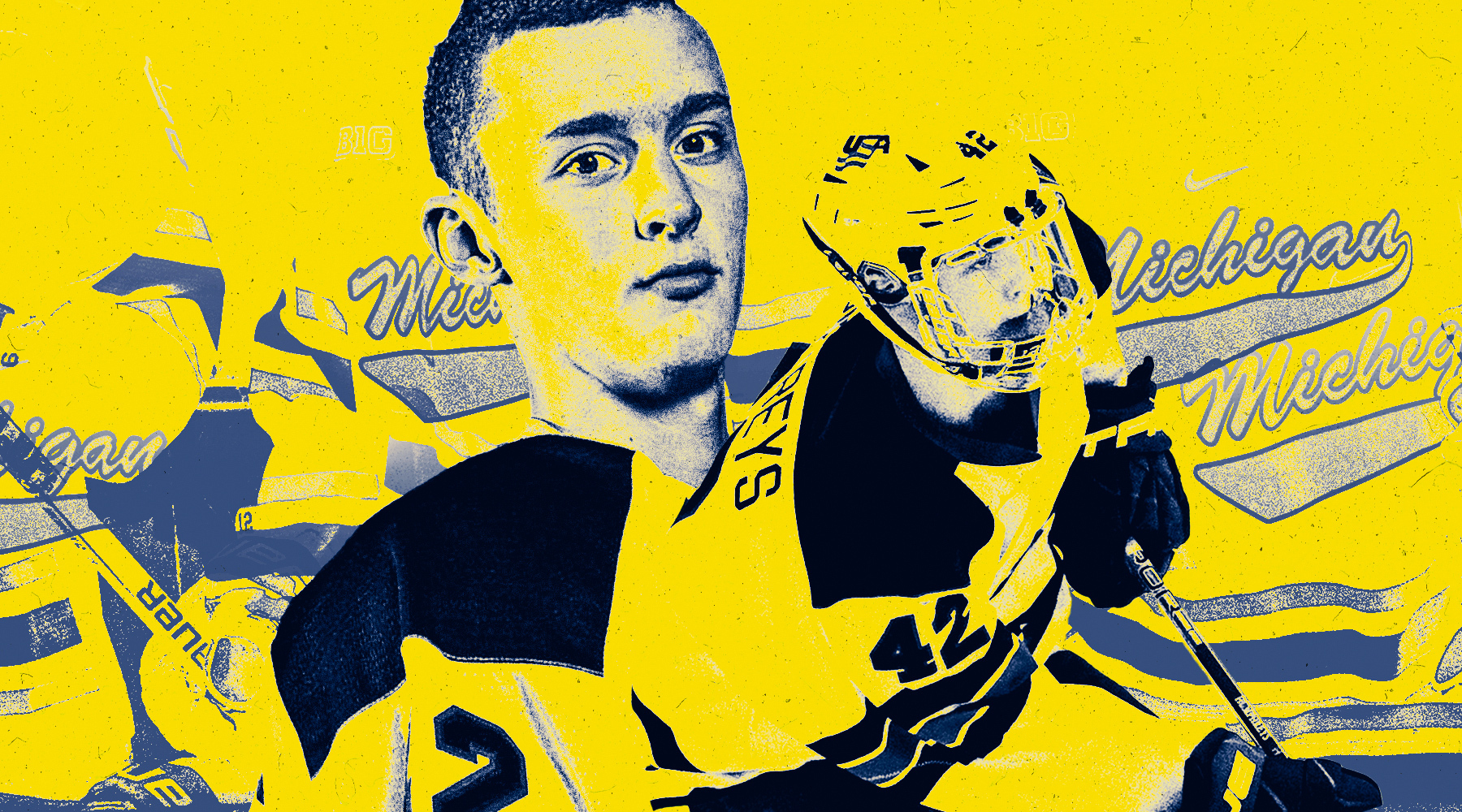NCAA Stock Watch: Frank Nazar is back

This article is presented by Everything College Hockey
This is when things start to get serious. Out-of-conference play is firmly in the rearview mirror. The stakes of every series have only gone up, with standings position on the line. The country's Nos. 1 and 2-ranked teams just squared up for an instant classic in Boston.
Operating in that backdrop are hundreds of NHL prospects, trying to distinguish themselves from their peers as they attempt to lead their programs to the tournament. Some have risen to the occasion; others are falling short of expectations.
We'll break it all down in the February NCAA Stock Watch, looking at whose stock is rising, falling, or holding steady.
Stock Rising 📈
Frank Nazar, C, Michigan (Chicago Blackhawks)
If you were worried that the glimpse of the old Frank Nazar that we saw at the World Juniors in Gothenburg was just a flash in the pan, let me ease your concerns – he's followed up his eight points in seven contests in his country's colours with 14 points in six contests as he's traded in the red of the American flag for Michigan maize.
The game is now increasingly slow for Nazar mentally as he ups the pace physically, a nice change from the player we saw last season. High-paced attacks off the rush characterized by inside drives and drawn pressure have permitted him to be one of the nation's most lethal transition playmakers. And he's flourished against pressure with look-offs, feints, and enough dangles to fill a highlight-reel all himself by the end of most series.
Now sitting comfortably above a point a game on our 10th-ranked team in the country, Nazar is starting to look every bit as good as we thought he would in college.
Ryan Healey, D, Harvard (Minnesota Wild)
Only four defencemen bested Ryan Healey's ten points in eight contests through the month of January, only two of which played in power conferences. That heater – which includes a pair of two-goal performances – raises his total to 18 points in 19 contests on the season, more than double last year's output in just less than half as many games.
Some of that is luck. Turn on the tape and you'll see a series of assists on net-front scrambles from point shots. It probably didn't hurt to convert on 21 percent of his shots in all-situations play, either.
You'll also see someone creating through a nice mix of high-value touches and volume. Many of Healey's points came off the rush, a feature of his up-tempo play and a willingness to court risk for the sake of a clean look up ice. The endless barrage of point shots as an answer to pressure that he can't escape hasn't hurt either.
Still, even in college, this is a player who's often pushing – exceeding, even – the upper limit of their skill set to create offence, often to his and his team's detriment. He's also not an especially sophisticated player either, opting for low-percentage dangles when presented with options and regularly missing opportunities to build plays.
Healey has earned his flowers, certainly, but there's a lot of work to be done on the margins to make him a player you can comfortably project to the next level. For now, you just gotta celebrate someone cookin'.
Owen McLaughlin, C, North Dakota (Philadelphia Flyers)
It's taken Owen McLaughlin perhaps a little bit longer than we expected to hit his stride with North Dakota, but he's turned that corner in the last two months and is looking like one of the best centres in all of the NCHC. And his 13 points in eight games through January did, indeed, lead the conference.
For McLaughlin, the biggest difference has been his added step as a skater. He's always been a cunning, dynamic distributor, but now he's finding ways to leverage those skills at pace, rather than relying on delays as a crutch to create off the rush. Instead, he's drawing pressure, driving the inside, using look-offs and feints before sliding the puck around defenders' sticks.
Away from the puck, the Flyers' seventh-rounder supports the puck with intelligent routes as a skater, working the underlap/overlap technique off the rush or driving defenders back to create space for the puck-carrier.
He's always been skilled, and that's what first drew us to McLaughlin in his draft-plus-one season with the Sioux City Musketeers. Now, he's finding ways to use those tools more effectively. That bodes well for his NHL chances.
Honourable mentions: Noah Laba (New York Rangers), Rutger McGroarty (Winnipeg Jets), Sam Rinzel (Chicago Blackhawks), Oliver Moore (Chicago Blackhawks), Jack Devine (Florida Panthers), Arseni Sergeyev (Calgary Flames), Vincent Borgesi (2024 NHL Draft)
Stock Steady ↔️
Tom Willander, D, Boston University (Vancouver Canucks)
There's no way around it: Tom Willander hasn't played up to the expectations of an 11th-overall pick during his freshman year with BU.
He's playing top pairing minutes alongside Lane Hutson on the nation's sixth-highest scoring team on a per-game basis and barely clearing half a point a game. This compares very poorly to most draft-plus-one defencemen with anything resembling his draft pedigree in the last four or five seasons.
It's not like he's thrived with the standout dimensions of his game either – transition and in-zone defensive play. Willander's internal clock still runs far too slowly for North American hockey with the puck on his stick, and his puck skills look well below average in this setting, too. He's been a capable on-puck defender, physically punishing and with a good defensive stick, but he's been much less efficient off-puck.
Here's why I'd exercise some caution before hitting the panic button, though: The NCAA is a brutally difficult entry point to North American hockey. Furthermore, he told me at the World Juniors in Gothenburg that he's emphasized improving his offensive side of the game since the draft. These could just be natural growing pains, given the circumstances, but it hasn't been easy to watch at times.
Stock Falling 📉
Sean Behrens, D, Denver (Colorado Avalanche)
It wouldn't necessarily be fair to characterize Sean Behrens as a worse player now than he has been in past seasons, but he's certainly a far cry different. Where he once profiled as one of the more creative and dynamic players from the offensive blue line in junior hockey, his almost three years in college have seen him develop into a much more reserved, almost shutdown-style defender.
It's been an interesting turn for Behrens. Standing just 5-foot-10 and playing on one of the most dynamic teams in college hockey, it's not the developmental path our staff imagined for him when we ranked him 23rd overall for the 2021 NHL draft.
Even so, Behrens has become one of the NCHC's most robust defenders. He gaps up early on opponents through the neutral zone, guides them to the outside, and closes with force as they try to gain the zone. The net-front is a no-fly zone when Behrens is on the ice, and he's an unrelenting force on puck retrievals.
The question we've been left to ask ourselves is whether someone with Behrens' profile can play that brand of hockey at the NHL level. There aren't many comps for us to lean on, and that's concerning given his declining offensive form.




